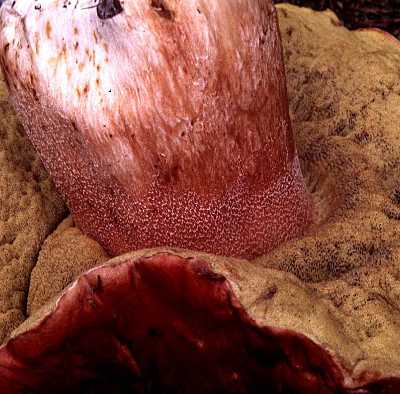Boletus edulis, King Bolete, Porcini, Steinpilz, or Cep
 Boletus edulis is fairly easy to identify. One of the common features of all the varieties are the chicken wire like reticulation on the stem at its apex (think of the reticulated giraffe, the pattern on the common giraffe is what is called reticulate). It will have a bronze coloured cap with a white or yellow underside and stem. Some may have a slightly green tint but they will never be red.
Boletus edulis is fairly easy to identify. One of the common features of all the varieties are the chicken wire like reticulation on the stem at its apex (think of the reticulated giraffe, the pattern on the common giraffe is what is called reticulate). It will have a bronze coloured cap with a white or yellow underside and stem. Some may have a slightly green tint but they will never be red.
 The fruit body consists of a large and imposing brown cap which can reach 25 cm (10 in) in diameter and 1 kg (2.2 lb) in weight. Like other boletes, it has tubes/pores extending downward from the underside of the cap, rather than gills; spores are released at maturity through the tube openings, or pores. The pore surface of the B. edulis fruit body is whitish when young, but ages to a greenish-yellow. The stout stipe, or stem, is white or yellowish in colour, up to 25 cm (10 in) tall and 7 cm (2.8 in) thick, and partially covered with a raised network pattern, or reticulations.
The fruit body consists of a large and imposing brown cap which can reach 25 cm (10 in) in diameter and 1 kg (2.2 lb) in weight. Like other boletes, it has tubes/pores extending downward from the underside of the cap, rather than gills; spores are released at maturity through the tube openings, or pores. The pore surface of the B. edulis fruit body is whitish when young, but ages to a greenish-yellow. The stout stipe, or stem, is white or yellowish in colour, up to 25 cm (10 in) tall and 7 cm (2.8 in) thick, and partially covered with a raised network pattern, or reticulations.
The fruit bodies can grow singly or in small clusters of two or three specimens. The mushroom's habitat consists of areas dominated by pine (Pinus spp.), spruce (Picea spp.), hemlock (Tsuga spp.) and fir (Abies spp.) trees, although other hosts include chestnut, chinquapin, beech, Keteleeria spp., Lithocarpus spp., and oak. The fungus forms symbiotic associations with living tree roots, and produces spore-bearing fruit bodies above ground in summer and autumn (they can be difficult to find being hidden amongst fallen needles / leaves).
Although fruit bodies may appear any time from summer to autumn, their growth is known to be triggered by rainfall during warm periods of weather followed by frequent autumn rain with a drop in soil temperature. Above average rainfall may result in the rapid appearance of large numbers of boletes, in what is known as a "bolete year". Studies have concluded that the maximal daily growth rate of the cap (about 21 mm or 0.8 in) occurs when the relative air humidity is greatest, and the fruit bodies ceased growing when the air humidity dropped below 40%. Factors most likely to inhibit the appearance of fruit bodies included prolonged drought, inadequate air and soil humidity, sudden decreases of night air temperatures, and the appearance of the first frost.
The flavour has been described as nutty and slightly meaty, with a smooth, creamy texture, and a distinctive aroma reminiscent of sourdough. Young, small porcini are most appreciated as the large ones often harbor maggots and become slimy, soft and less tasty with age. Peeling and washing are not recommended. The fruit bodies are highly perishable, due largely to the high water content (around 90%), the high level of enzyme activity, and the presence of a flora of microorganisms. When you cut them lengthways - the insides remain white. the underside of the cap is always sponge like on a Cep.
Fruit bodies are collected by holding the stipe near the base and twisting gently. Cutting the stipe with a knife may risk the part left behind rotting and the mycelium being destroyed.
http://www.mushrooms.org.uk/ is a good UK mushroom site

